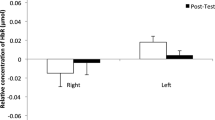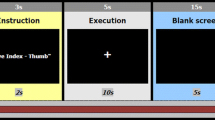Abstract
Recently, much discussion has been centered on the brain networks of recall, memory, and execution. This study utilized functional magnetic resonance imaging to compare activation between a simple sequential finger movement (real task) and recalling the same task (imagery task) in 15 right-handed normal subjects. The results demonstrated a greater activation in the contralateral motor and somatosensory cortex during the real task, and a higher activation in the contralateral inferior frontal cortex, ipsilateral motor, somatosensory cortex, and midbrain during the imagery task. These real task-specific areas and imagery-specific areas, including the ipsilateral motor and somatosensory cortex, are consistent with recent studies. However, this is the first report to demonstrate that the imagery-specific regions involve the ipsilateral inferior frontal cortex and midbrain. Directly comparing the activation between real and imagery tasks demonstrated the inferior frontal cortex and midbrain to therefore play important roles in cognitive feedback.



Similar content being viewed by others
References
Alexander, G. E., & Crutcher, M. D. (1990). Neural representations of the target (goal) of visually guided arm movements in three motor areas of the monkey. Journal of Neurophysiology, 64, 164–178.
Badre, D., & Wagner, A. D. (2007). Left ventrolateral prefrontal cortex and the cognitive control of memory. Neuropsychologia, 45, 2883–2901.
Donchin, O., Gribova, A., Steinberg, O., Bergman, H., & Vaadia, E. (1998). Primary motor cortex is involved in bimanual coordination. Nature, 395, 274–278.
Florio, T., Capozzo, A., Cellini, R., Pizzuti, G., Staderini, E. M., & Scarnati, E. (2001). Unilateral lesions of the pedunculopontine nucleus do not alleviate subthalamic nucleus-mediated anticipatory responding in a delayed sensorimotor task in the rat. Behavioural Brain Research, 126, 93–103.
Gerardin, E., Sirigu, A., Lehericy, S., Poline, J. B., Gaymard, B., Marsault, C., et al. (2000). Partially overlapping neural networks for real and imagined hand movements. Cerebral Cortex, 10, 1093–1104.
Hanakawa, T., Honda, M., Okada, T., Fukuyama, H., & Shibasaki, H. (2003). Neural correlates underlying mental calculation in abacus experts: a functional magnetic resonance imaging study. Neuroimage, 19, 296–307.
Hanakawa, T., Dimyan, M. A., Hallett, M. (2008). Motor planning, imagery, and execution in the distributed motor network: a time-course study with functional MRI. Cerebral Cortex.
Kansaku, K., Muraki, S., Umeyama, S., Nishimori, Y., Kochiyama, T., Yamane, S., et al. (2005). Cortical activity in multiple motor areas during sequential finger movements: an application of independent component analysis. Neuroimage, 2, 669–681.
Lotze, M., Heymans, U., Birbaumer, N., Veit, R., Erb, M., Flor, H., et al. (2006). Differential cerebral activation during observation of expressive gestures and motor acts. Neuropsychologia, 44, 1787–1795.
Mushiake, H., Inase, M., & Tanji, J. (1991). Neuronal activity in the primate premotor, supplementary, and precentral motor cortex during visually guided and internally determined sequential movements. Journal of Neurophysiology, 66, 705–718.
Ogawa, S., Lee, T. M., Kay, A. R., & Tank, D. W. (1990). Brain magnetic resonance imaging with contrast dependent on blood oxygenation. Proceedings of the National Academy of Sciences of the United States of America, 87, 9868–9872.
Penfield, W. (1950). The supplementary motor area in the cerebral cortex of man. Arch Psychiatr Nervenkr Z Gesamte Neurol Psychiatr, 185, 670–674.
Penfield, W., & Welch, K. (1949). Instability of response to stimulation of the sensorimotor cortex of man. Journal of Physiology, 109, 358–365. illust.
Richter, W., Andersen, P. M., Georgopoulos, A. P., & Kim, S. G. (1997). Sequential activity in human motor areas during a delayed cued finger movement task studied by time-resolved fMRI. NeuroReport, 8, 1257–1261.
Rizzolatti, G., & Craighero, L. (2004). The mirror-neuron system. Annual Review of Neuroscience, 27, 169–192.
Roland, P. E., Larsen, B., Lassen, N. A., & Skinhoj, E. (1980). Supplementary motor area and other cortical areas in organization of voluntary movements in man. Journal of Neurophysiology, 43, 118–136.
Sawamura, H., Shima, K., & Tanji, J. (2002). Numerical representation for action in the parietal cortex of the monkey. Nature, 415, 918–922.
Shima, K., & Tanji, J. (1998). Both supplementary and presupplementary motor areas are crucial for the temporal organization of multiple movements. Journal of Neurophysiology, 80, 3247–3260.
Sirigu, A., Duhamel, J. R., Cohen, L., Pillon, B., Dubois, B., & Agid, Y. (1996). The mental representation of hand movements after parietal cortex damage. Science, 273, 1564–1568.
Wagner, A. D., Maril, A., Bjork, R. A., & Schacter, D. L. (2001). Prefrontal contributions to executive control: fMRI evidence for functional distinctions within lateral prefrontal cortex. Neuroimage, 14, 1337–1347.
Acknowledgement
This research was supported by MEXT (Grant-in-aid No.20790846).
Author information
Authors and Affiliations
Corresponding author
Rights and permissions
About this article
Cite this article
Ueno, T., Inoue, M., Matsuoka, T. et al. Comparison Between a Real Sequential Finger and Imagery Movements: An fMRI Study Revisited. Brain Imaging and Behavior 4, 80–85 (2010). https://doi.org/10.1007/s11682-009-9087-y
Published:
Issue Date:
DOI: https://doi.org/10.1007/s11682-009-9087-y




